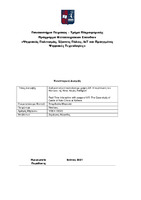Διαδραστική οπτικοποίηση με χρήση AR. Η περίπτωση του Κάστρου της Κάτω Χώρας Κυθήρων
Real-time interactive with usage of AR. The case study of Castle of Kato Chora at Kythera

View/
Keywords
Augmented reality ; Kythera island ; Android application ; Unity ; 3d model - map ; Digital culture ; Archeological site ; Android AppAbstract
The practices of collecting, documenting and highlighting historical / archaeological objects and places of culture are gradually being replaced by new methods, the digital ones. In recent years the use of new methods has become increasingly popular due to developments in technology and the interaction that exists between visitors and places of culture. In addition, the advantages that arise from them are many as they lead to digital representations of monuments, interactive museum exhibitions and historical narratives (Economou and Pujol -Tost, 2011). The 2020 pandemic (Covid-19) has forced the majority of cultural institutions around the world to operate as start-up companies. Therefore and in an inventive way, exhibitions, tours and educational programs were redesigned, maintaining the interest of the public through their digital presence. At the same time, smaller-scale actions were carried out at the archeological sites. However, due to technological infrastructure, the archeological sites remain at a disadvantage. This dissertation will show how the contribution of technology can help and at the same time attract the modern visitor by allowing him to better explore a monument by "talking" to him digitally. The castle, the individual buildings and the sacred temples that are included in the Lower Town of Mylopotamos, Kythera, were selected as a case study. Based on this, an augmented reality application was designed and developed, which will work on android devices and will be the main guide for the visitor, who will want to receive more information about the history of the site. The research carried out included the evaluation of the quality of the services offered as well as their recreational and educational value. Overall, the result of the present research will evaluate the quality of augmented reality applications in archaeological sites and how they can become an integral part of them.


